A leading non-partisan tax policy researcher, The Tax Foundation, estimates that your first 111 days belong to the U.S. government. When the estimate includes the effect of federal borrowing, the date moves to May 6. In other words, you work for Uncle Sam in your first 125 days of a given year, while the remaining 240 belong to you.
The effect of federal borrowing cannot be understated. Right now, you work an extra 14 days to pay the interest on the country’s debt. On the other hand, the Federal Reserve’s zero-interest-rate policy coupled with quantitative easing (”QE”) has kept the borrowing costs for the U.S. exceptionally low. If rates returned to “normal,” the current 6.4% of tax dollars going toward interest on sovereign debt would likely jump to 12.5%. Instead of working until May 6 to reach “Tax Freedom Day,” you may need to wait until June approaches.
Keep in mind, I haven’t mentioned the probability that tax rates for families are likely to climb. Consider Congressional Budget Office (CBO) data that shows the trend of an increasing burden on the top 20% earners, not just the much-maligned 1%. The Wall Street Journal, citing the CBO data, explained that increased taxation of a couple with two children making more than $150,000 has jumped from 65% in 1980 to more than 90% by 2010.
Think increases in taxes will only hit the top 20% of income earning families? Then you must not be paying attention. Due to a lack of savings by “Boomers” and “Gen Xers,” as well as an increasingly aging population and new entitlements, the U.S. will need to collect as much as 25% more tax revenue above the average percentage (17.4%) of gross domestic product (GDP). Yet half of Americans effectively contribute zero dollars to the present tax system. Indeed, one does not need to be psychic to foresee the onerous tax hikes ahead.
Granted, there are scores of legitimate ways to reduce a tax albatross. One family might look to shift some W-2 earnings to 1099 income such that the side business activity offers deductible expenses. Another family might move from a high-tax state to a lower-tax state. Still, are there ways that a market-based investor can reduce the number of days that Uncle Sam has commandeered?
The short answer is, “Yes.”
Unfortunately, most people’s imagination rarely moves beyond tax deferral in an employer-sponsored plan. Tax deferral is remarkably beneficial in compounding the growth of a portfolio. On the other hand, pushing one’s tax obligation out into the future is not the same as shrinking it or eliminating it.
The ETF
Enter the exchange-traded index fund. An ETF that tracks an established index does not distribute significant capital gains the way a traditional mutual fund might. For one thing, an index does not change very much, if at all. Without the need to change what the ETF holds, the lack of trading activity means there are less distributions to shareholders for tax consequences. Similarly, outflows force the sale of securities in mutual funds; the redemption process for an ETF is different than the process for a mutual fund whereby the ETF structure enhances tax efficiency.
According to a 2012 study at Morningstar, the 5-year average distribution for a large-cap stock blend mutual fund was nearly 2%. ETFs? 0%. For one who might have $200,000 in large stock mutual fund exposure, that’d be four thousand dollars in capital gains distributions annually. Five years of holding the large cap fund would cost $600 per year at a 15% capital gains rate for a total of $3000. Simply selecting iShares S&P 500 (ARCA:IVV) in one’s brokerage account would eliminate the levy.
Outside of the stock arena, distaste for capital gains distributions morphs into disdain for the taxation of interest income. Those who find themselves in a very high marginal tax bracket might do well to skip straight to the no-tax world of municipal bonds. It is true that the rapid rise in interest rates that followed the Fed’s tapering announcement in May of 2013 served to punish munis mercilessly. SPDR Nuveen Muni Bond (TFI) logged -3.9% last year.
However, last year’s muni bashing created opportunity for those who wish to pursue income free from federal taxation. TFI quickly recovered a technical uptrend, already garnering 4.5% year-to-date. For an investor in the 35% tax bracket, the taxable bond equivalent yield is 6.9% YTD — a return that simply cannot be matched by intermediate-term investment grade bond funds. Longer-term munis in Market Vectors Long (MLN) have also been winners.
Obviously, investing in anything for tax benefits alone is likely to bite in unexpected and undesirable ways. Nevertheless, one can consider the favorable spreads that munis offer the high marginal tax bracket investor. A fund that I like for taxable as well as non-taxable accounts is PIMCO Short-Term High Yield (HYS). It may offer a 4.3% yield with relatively low risk. Now consider Market Vectors Short-Term High Yield Muni (SHYD) with a projected 3.9% yield net of fees. In a 35% marginal bracket, a 6.0% taxable equivalent yield makes SHYD an attractive prospect.
Disclosure: Gary Gordon, MS, CFP is the president of Pacific Park Financial, Inc., a Registered Investment Adviser with the SEC. Gary Gordon, Pacific Park Financial, Inc, and/or its clients may hold positions in the ETFs, mutual funds, and/or any investment asset mentioned above. The commentary does not constitute individualized investment advice. The opinions offered herein are not personalized recommendations to buy, sell or hold securities. At times, issuers of exchange-traded products compensate Pacific Park Financial, Inc. or its subsidiaries for advertising at the ETF Expert web site. ETF Expert content is created independently of any advertising relationships.


